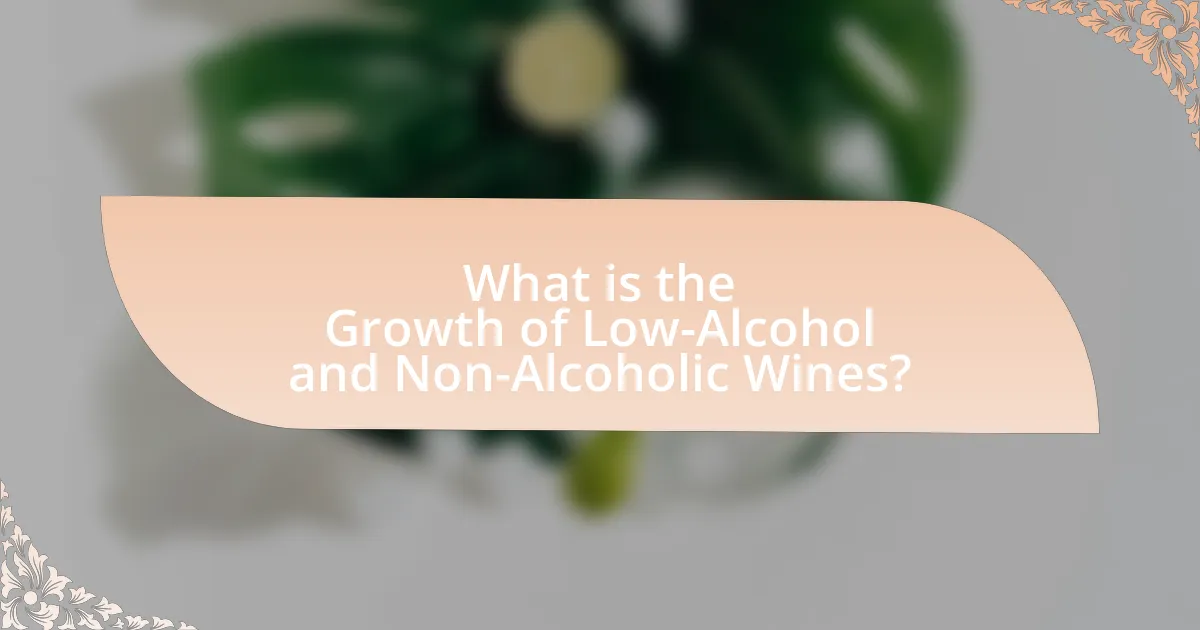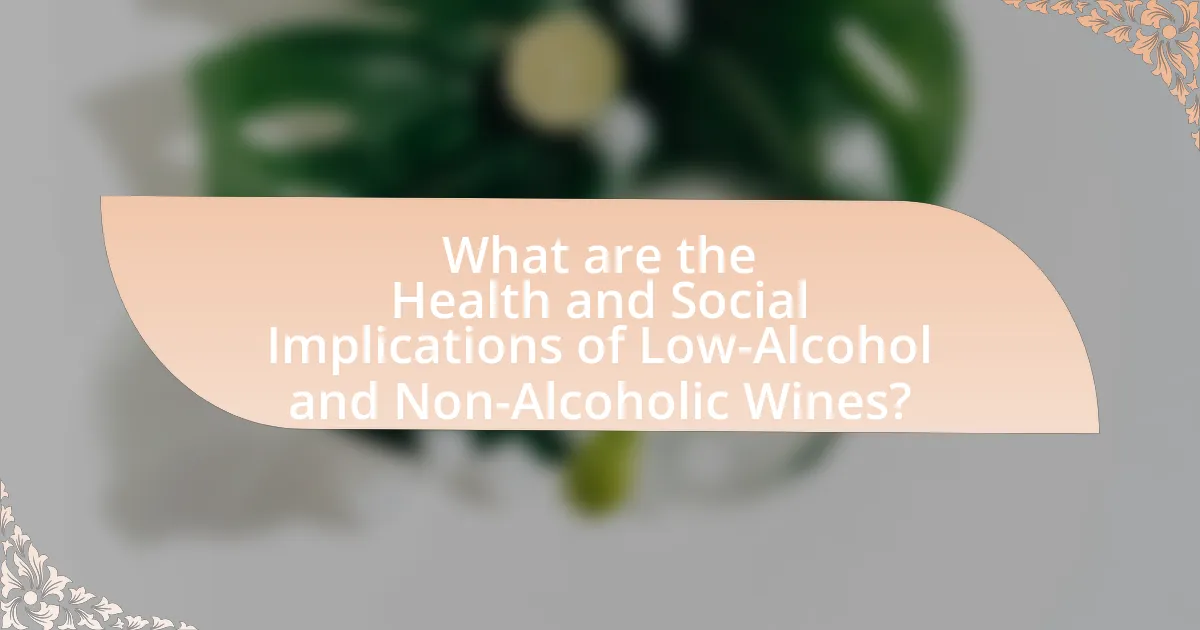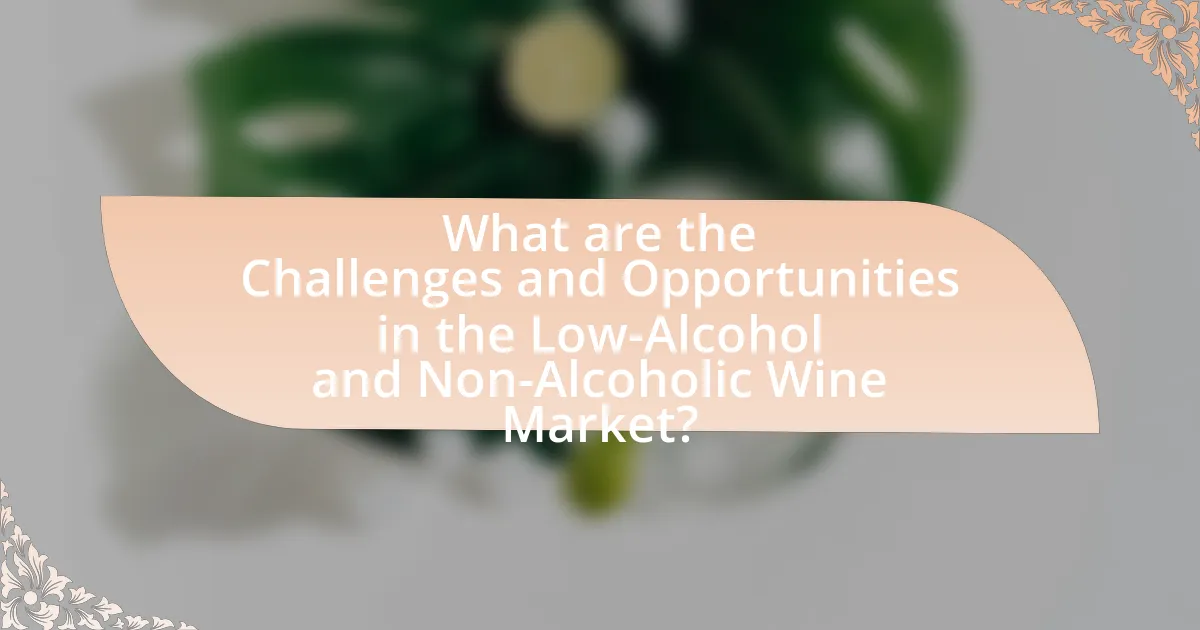The article analyzes the significant growth of low-alcohol and non-alcoholic wines, projecting the global market for non-alcoholic wine to reach approximately $1.6 billion by 2025, with a compound annual growth rate of around 8.5%. Key factors driving this trend include rising health consciousness, changing social norms regarding alcohol consumption, and an expanding variety of products. The article also explores the demographics influencing demand, particularly millennials and health-conscious consumers, while addressing the health and social implications of these wines. Additionally, it discusses the challenges and opportunities within the market, including production methods, regulatory hurdles, and strategies for brands to capture a larger market share.

What is the Growth of Low-Alcohol and Non-Alcoholic Wines?
The growth of low-alcohol and non-alcoholic wines has been significant, with the global market for non-alcoholic wine projected to reach approximately $1.6 billion by 2025, reflecting a compound annual growth rate (CAGR) of around 8.5% from 2020. This increase is driven by rising health consciousness among consumers, changing social norms regarding alcohol consumption, and the expanding variety of products available. For instance, a report by IWSR Drinks Market Analysis indicates that the non-alcoholic wine segment has seen a 30% increase in sales in recent years, highlighting a shift in consumer preferences towards healthier alternatives.
How has the market for low-alcohol and non-alcoholic wines evolved over recent years?
The market for low-alcohol and non-alcoholic wines has experienced significant growth in recent years, driven by changing consumer preferences towards healthier lifestyles. According to a report by IWSR Drinks Market Analysis, the global market for non-alcoholic wine is projected to grow by 31% from 2020 to 2024, indicating a strong upward trend. This shift is largely influenced by an increasing number of consumers seeking alternatives to traditional alcoholic beverages, particularly among millennials and health-conscious individuals. Additionally, major wine producers have expanded their offerings in this segment, with brands like Heineken and Constellation Brands launching new non-alcoholic options, further validating the market’s evolution.
What factors have contributed to the increasing popularity of these wines?
The increasing popularity of low-alcohol and non-alcoholic wines is primarily driven by health consciousness among consumers. As more individuals prioritize wellness and seek to reduce alcohol intake, the demand for alternatives that offer similar taste experiences without the negative effects of alcohol has surged. According to a report by IWSR Drinks Market Analysis, the non-alcoholic wine segment grew by 30% in 2020, reflecting a significant shift in consumer preferences towards healthier drinking options. Additionally, the rise of social media and lifestyle influencers promoting moderation and mindful drinking has further amplified interest in these wines, making them more accessible and appealing to a broader audience.
How do consumer preferences influence the growth of this segment?
Consumer preferences significantly influence the growth of the low-alcohol and non-alcoholic wine segment by driving demand for healthier and more mindful drinking options. As consumers increasingly prioritize health and wellness, the market for low-alcohol and non-alcoholic wines has expanded, with sales growing by 30% in the past year alone, according to a report by IWSR Drinks Market Analysis. This shift in preference is also reflected in changing social norms, where moderation is becoming more accepted, leading to a broader acceptance and availability of these products in retail and hospitality sectors.
What are the key demographics driving the demand for low-alcohol and non-alcoholic wines?
The key demographics driving the demand for low-alcohol and non-alcoholic wines include millennials and health-conscious consumers. Millennials, who prioritize wellness and moderation, are increasingly seeking alternatives that align with their lifestyle choices. According to a report by IWSR, the global market for non-alcoholic beverages, including wines, is projected to grow significantly, with millennials being a primary driver of this trend. Additionally, health-conscious consumers, including those who are reducing alcohol intake for health reasons or personal preference, are contributing to the rising popularity of these products. This demographic shift is supported by changing social norms and increased awareness of the health impacts of alcohol consumption.
Which age groups are most interested in these products?
The age groups most interested in low-alcohol and non-alcoholic wines are primarily millennials and Generation Z. Research indicates that approximately 66% of millennials and 50% of Generation Z consumers are actively seeking low-alcohol and non-alcoholic options, driven by health consciousness and lifestyle choices. This trend is supported by a report from IWSR Drinks Market Analysis, which highlights a significant increase in demand for these products among younger demographics, reflecting changing attitudes towards alcohol consumption.
How do lifestyle choices impact consumer interest in low-alcohol and non-alcoholic wines?
Lifestyle choices significantly influence consumer interest in low-alcohol and non-alcoholic wines, as health-conscious individuals increasingly seek alternatives that align with their wellness goals. The rise in popularity of these wines correlates with a broader trend towards moderation in alcohol consumption, driven by factors such as increased awareness of health risks associated with excessive drinking and a growing preference for mindful drinking practices. According to a 2021 report by IWSR, the global market for low-alcohol and non-alcoholic beverages is projected to grow by 31% by 2024, indicating a strong consumer shift towards these options. This trend is further supported by changing social norms, where consumers are more inclined to choose beverages that allow for social participation without the effects of alcohol.

What are the Health and Social Implications of Low-Alcohol and Non-Alcoholic Wines?
Low-alcohol and non-alcoholic wines have significant health and social implications, primarily promoting safer drinking habits and reducing alcohol-related health risks. These beverages provide an alternative for individuals seeking to enjoy wine without the intoxicating effects of alcohol, thereby decreasing the likelihood of alcohol dependency and related health issues such as liver disease and cardiovascular problems.
Research indicates that low-alcohol and non-alcoholic wines can help individuals maintain social connections while avoiding the negative consequences of excessive alcohol consumption. A study published in the journal “Alcohol and Alcoholism” found that non-alcoholic options can enhance social experiences without the impairments associated with alcohol, fostering inclusivity in social settings.
Furthermore, the increasing popularity of these wines reflects a broader societal shift towards health-conscious choices, as evidenced by market trends showing a rise in sales of low-alcohol and non-alcoholic beverages. This shift not only supports individual health but also contributes to changing social norms around drinking, encouraging moderation and responsible consumption.
How do low-alcohol and non-alcoholic wines fit into a healthy lifestyle?
Low-alcohol and non-alcoholic wines fit into a healthy lifestyle by providing a beverage option that minimizes alcohol consumption while still offering the sensory experience of traditional wines. These alternatives typically contain less than 0.5% alcohol by volume, significantly reducing the risks associated with alcohol consumption, such as liver disease and addiction. Studies indicate that moderate alcohol consumption can be linked to certain health benefits, but low-alcohol and non-alcoholic wines allow individuals to enjoy similar flavors without the negative health impacts. Additionally, these wines often contain antioxidants, which can contribute to heart health, making them a suitable choice for those seeking to maintain a balanced diet.
What health benefits are associated with consuming low-alcohol and non-alcoholic wines?
Consuming low-alcohol and non-alcoholic wines offers several health benefits, including reduced risk of alcohol-related diseases, improved hydration, and potential cardiovascular benefits. Research indicates that low-alcohol wines can provide the positive effects of traditional wines, such as antioxidants like resveratrol, without the negative impacts of higher alcohol content. A study published in the Journal of Nutritional Biochemistry found that moderate consumption of non-alcoholic red wine can improve endothelial function, which is crucial for cardiovascular health. Additionally, non-alcoholic wines can be a healthier alternative for individuals looking to reduce their alcohol intake while still enjoying the taste and social aspects of wine consumption.
How do these wines compare to traditional alcoholic beverages in terms of health risks?
Low-alcohol and non-alcoholic wines generally present lower health risks compared to traditional alcoholic beverages. Traditional alcoholic beverages, particularly those with higher alcohol content, are associated with various health issues, including liver disease, addiction, and increased risk of certain cancers. In contrast, low-alcohol and non-alcoholic wines typically contain less than 0.5% alcohol by volume, significantly reducing the risk of alcohol-related health problems. Studies indicate that moderate consumption of low-alcohol options can provide similar social benefits without the adverse effects linked to higher alcohol consumption, such as impaired cognitive function and increased blood pressure.
What social trends are influencing the acceptance of low-alcohol and non-alcoholic wines?
The acceptance of low-alcohol and non-alcoholic wines is influenced by several social trends, including the growing health consciousness among consumers, the rise of mindful drinking, and the increasing popularity of wellness lifestyles. Health-conscious consumers are increasingly aware of the negative effects of alcohol consumption, leading to a demand for alternatives that allow for social enjoyment without the associated health risks. The mindful drinking movement encourages individuals to be more intentional about their alcohol intake, promoting moderation and the enjoyment of non-alcoholic options. Additionally, the wellness lifestyle trend emphasizes holistic health, further driving interest in beverages that align with these values. According to a report by IWSR, the global market for non-alcoholic beverages is projected to grow significantly, reflecting these changing consumer preferences.
How is the perception of alcohol consumption changing in society?
The perception of alcohol consumption is shifting towards moderation and health consciousness in society. Increasing awareness of the negative health effects associated with excessive drinking, such as liver disease and addiction, has led to a rise in demand for low-alcohol and non-alcoholic alternatives. According to a report by IWSR Drinks Market Analysis, the global market for non-alcoholic beverages is projected to grow significantly, with a 31% increase in sales expected by 2024. This trend reflects a broader cultural movement that prioritizes wellness and responsible drinking, influencing consumer choices and prompting brands to innovate in the low-alcohol and non-alcoholic wine sectors.
What role do social media and marketing play in promoting these wines?
Social media and marketing are crucial in promoting low-alcohol and non-alcoholic wines by enhancing brand visibility and engaging target audiences. These platforms allow wineries to showcase their products through visually appealing content, reaching a broader demographic that values health-conscious choices. For instance, a study by the Wine Market Council indicates that 30% of consumers are actively seeking low-alcohol options, highlighting the demand that social media campaigns can effectively tap into. Additionally, influencer partnerships on platforms like Instagram can drive consumer interest and credibility, as followers often trust recommendations from figures they admire. This strategic use of social media and marketing not only increases awareness but also fosters community engagement around the lifestyle associated with low-alcohol and non-alcoholic wines.

What are the Challenges and Opportunities in the Low-Alcohol and Non-Alcoholic Wine Market?
The challenges in the low-alcohol and non-alcoholic wine market include consumer perception, taste profile, and regulatory hurdles. Many consumers associate non-alcoholic wines with inferior quality, which can hinder market acceptance. Additionally, achieving a taste that closely resembles traditional wines remains a significant challenge for producers, as many low-alcohol options do not meet consumer expectations. Regulatory issues, such as labeling and marketing restrictions, can also complicate the introduction of new products.
Conversely, opportunities in this market are driven by increasing health consciousness and changing consumer preferences. A growing number of consumers are seeking healthier lifestyle choices, which has led to a rise in demand for low-alcohol and non-alcoholic options. According to a report by IWSR, the non-alcoholic wine market is projected to grow by 31% by 2024, indicating a significant opportunity for brands to capture this expanding consumer base. Furthermore, innovative production techniques and flavor enhancements present avenues for brands to improve product offerings and attract a broader audience.
What challenges do producers face in creating low-alcohol and non-alcoholic wines?
Producers face significant challenges in creating low-alcohol and non-alcoholic wines, primarily related to maintaining flavor and quality while reducing alcohol content. The process of removing alcohol can lead to undesirable changes in taste and aroma, as traditional fermentation methods are altered. Additionally, achieving a balance between sweetness and acidity becomes more complex, as lower alcohol levels can affect the perception of these elements.
Moreover, the technological limitations in alcohol removal techniques, such as reverse osmosis or vacuum distillation, can result in loss of desirable compounds that contribute to the wine’s character. According to a study published in the Journal of Wine Research, producers often struggle with consumer perceptions, as many associate lower alcohol wines with inferior quality. This perception can hinder market acceptance and growth in the segment.
Furthermore, regulatory challenges exist, as different regions have varying definitions and standards for labeling wines as non-alcoholic, complicating production and marketing efforts. These factors collectively create a challenging environment for producers aiming to innovate in the low-alcohol and non-alcoholic wine market.
How do production methods affect the quality of these wines?
Production methods significantly influence the quality of low-alcohol and non-alcoholic wines by affecting flavor, aroma, and overall sensory experience. Techniques such as fermentation control, temperature management, and the use of specific yeast strains can enhance the preservation of desirable characteristics while minimizing undesirable elements. For instance, the use of reverse osmosis or vacuum distillation in the production of non-alcoholic wines allows for the removal of alcohol while retaining the wine’s original flavors, leading to a product that closely resembles traditional wines in taste and aroma. Studies have shown that wines produced with careful attention to these methods can achieve a quality comparable to their alcoholic counterparts, thereby appealing to a broader consumer base.
What regulatory hurdles must be navigated in this market?
The regulatory hurdles that must be navigated in the low-alcohol and non-alcoholic wine market include compliance with labeling laws, taxation regulations, and health claims restrictions. In many jurisdictions, products labeled as “non-alcoholic” must contain less than 0.5% alcohol by volume, which requires rigorous testing and certification processes. Additionally, varying state and federal taxes on alcoholic beverages can complicate pricing strategies and market entry. Furthermore, health claims made on packaging must adhere to specific guidelines set by regulatory bodies, such as the Food and Drug Administration in the United States, to avoid misleading consumers. These regulations can significantly impact production, marketing, and distribution strategies within the market.
What opportunities exist for growth in the low-alcohol and non-alcoholic wine sector?
The low-alcohol and non-alcoholic wine sector presents significant growth opportunities driven by increasing consumer health consciousness and changing social norms. The global market for non-alcoholic wine is projected to grow at a compound annual growth rate (CAGR) of 8.5% from 2021 to 2028, indicating a rising demand for healthier beverage options. Additionally, the expansion of distribution channels, including online sales and specialty retailers, enhances accessibility for consumers. The trend towards mindful drinking, particularly among millennials and Gen Z, further supports the potential for innovation in flavors and product offerings, catering to diverse consumer preferences.
How can innovation drive new product development in this category?
Innovation can drive new product development in the low-alcohol and non-alcoholic wine category by introducing advanced fermentation techniques and flavor enhancement methods. These innovations allow producers to create wines that maintain the complexity and taste profile of traditional wines while reducing alcohol content. For instance, the use of reverse osmosis and spinning cone technology enables winemakers to extract alcohol without compromising the wine’s flavor, resulting in products that appeal to health-conscious consumers. According to a report by IWSR, the global market for low-alcohol and non-alcoholic beverages is projected to grow by 31% by 2024, indicating a strong consumer demand for innovative products in this category.
What strategies can brands employ to capture a larger market share?
Brands can capture a larger market share by focusing on product innovation, targeted marketing, and strategic partnerships. Product innovation involves developing unique low-alcohol and non-alcoholic wine offerings that cater to evolving consumer preferences, such as health-conscious choices and flavor diversity. Targeted marketing strategies, including social media campaigns and influencer collaborations, can effectively reach specific demographics interested in these products. Strategic partnerships with retailers and restaurants can enhance visibility and accessibility, driving sales. According to a report by IWSR, the low-alcohol and non-alcoholic wine market is projected to grow significantly, indicating a strong opportunity for brands to expand their market presence.
What are the best practices for consumers interested in low-alcohol and non-alcoholic wines?
Consumers interested in low-alcohol and non-alcoholic wines should prioritize reading labels to understand alcohol content and ingredients. This practice ensures they select products that meet their preferences and dietary needs. Additionally, exploring various brands and styles can enhance their experience, as the market offers a diverse range of flavors and profiles. Research indicates that the low-alcohol and non-alcoholic wine market has grown significantly, with a 2021 report from IWSR stating that non-alcoholic wine sales increased by 31% in the previous year, reflecting rising consumer interest. Engaging with knowledgeable staff at wine shops or attending tastings can also provide valuable insights into the best options available.